engine Lexus IS250C 2010 Do-It-Yourself Maintenance / LEXUS 2010 IS350C/250C OWNERS MANUAL (OM53A20U)
[x] Cancel search | Manufacturer: LEXUS, Model Year: 2010, Model line: IS250C, Model: Lexus IS250C 2010Pages: 592, PDF Size: 7.18 MB
Page 535 of 592
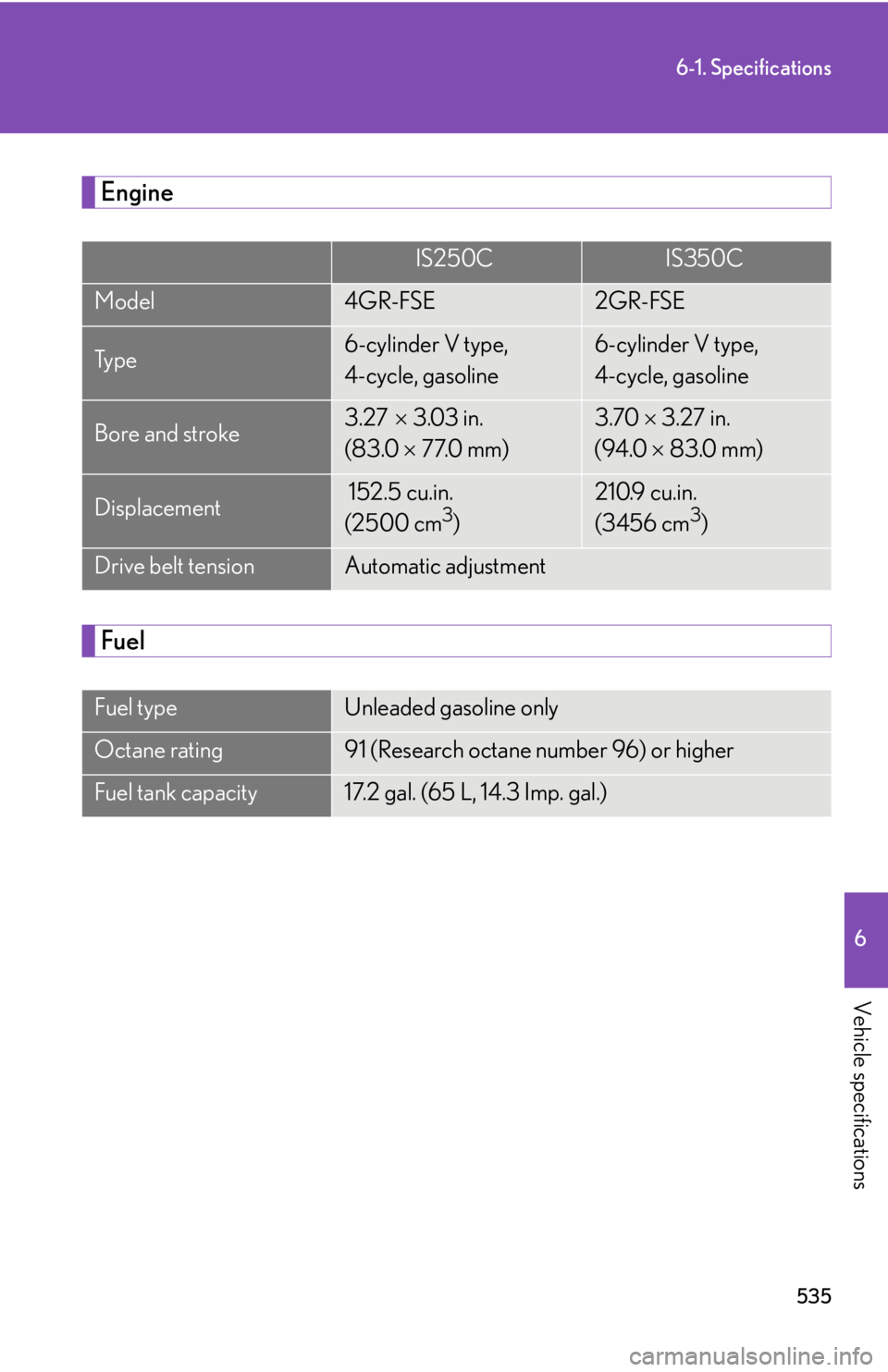
535
6-1. Specifications
6
Vehicle specifications
Engine
Fuel
IS250CIS350C
Model4GR-FSE2GR-FSE
Ty p e6-cylinder V type,
4-cycle, gasoline6-cylinder V type,
4-cycle, gasoline
Bore and stroke3.27 3.03 in.
(83.0 77.0 mm)3.70 3.27 in.
(94.0 83.0 mm)
Displacement 152.5 cu.in.
(2500 cm3)
210.9 cu.in.
(3456 cm3)
Drive belt tensionAutomatic adjustment
Fuel typeUnleaded gasoline only
Octane rating91 (Research octane number 96) or higher
Fuel tank capacity17.2 gal. (65 L, 14.3 Imp. gal.)
Page 536 of 592
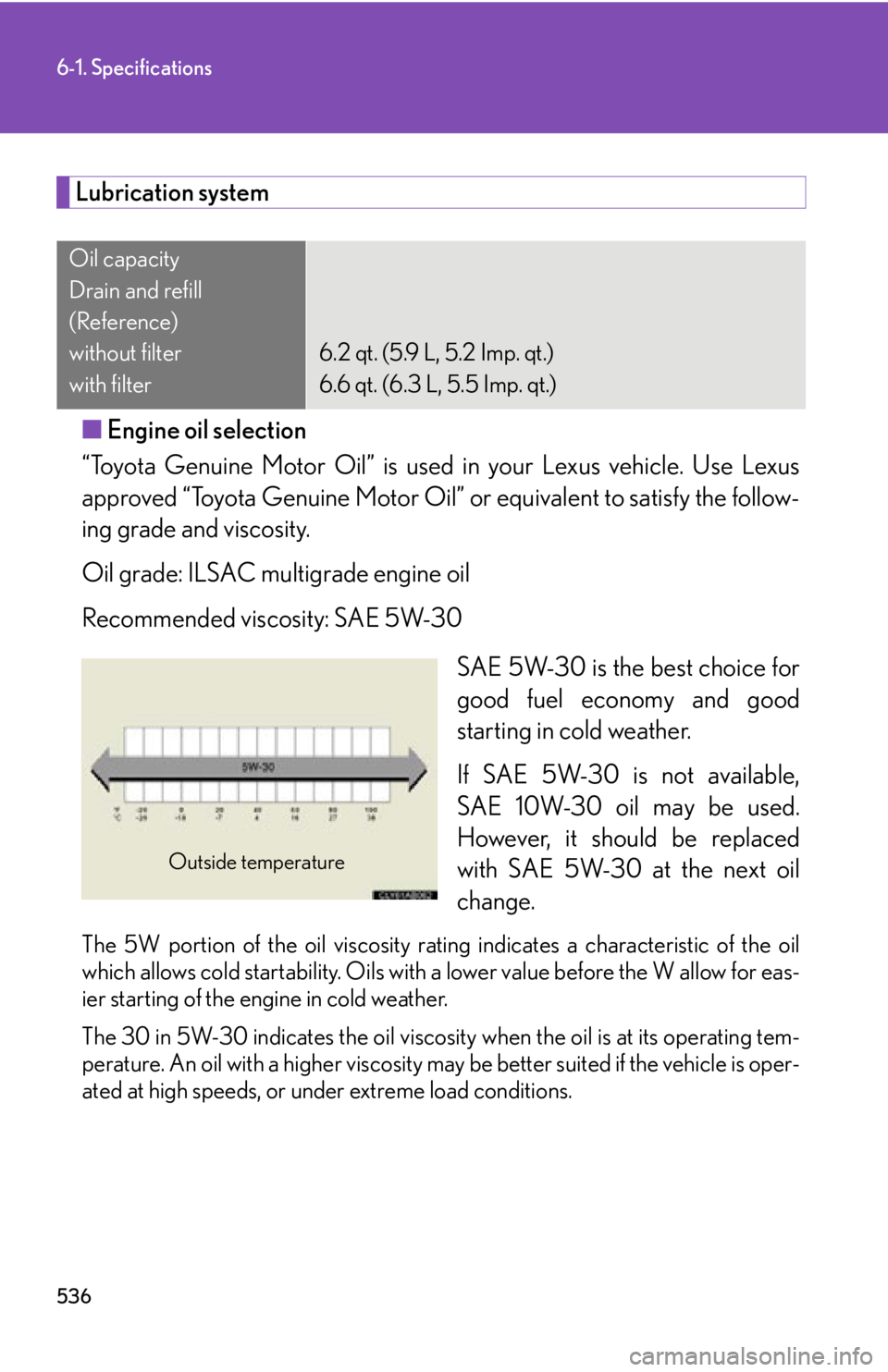
536
6-1. Specifications
Lubrication system■ Engine oil selection
“Toyota Genuine Motor Oil” is used in your Lexus vehicle. Use Lexus
approved “Toyota Genuine Motor Oil” or equivalent to satisfy the follow-
ing grade and viscosity.
Oil grade: ILSAC multigrade engine oil
Recommended viscosity: SAE 5W-30
SAE 5W-30 is the best choice for
good fuel economy and good
starting in cold weather.
If SAE 5W-30 is not available,
SAE 10W-30 oil may be used.
However, it should be replaced
with SAE 5W-30 at the next oil
change.
The 5W portion of the oil viscosity rating indicates a characteristic of the oil
which allows cold startability. Oils with a lower value before the W allow for eas-
ier starting of the engine in cold weather.
The 30 in 5W-30 indicates the oil viscosit y when the oil is at its operating tem-
perature. An oil with a higher viscosity may be better suited if the vehicle is oper-
ated at high speeds, or un der extreme load conditions.
Oil capacity
Drain and refill
(Reference)
without filter
with filter
6.2 qt. (5.9 L, 5.2 Imp. qt.)
6.6 qt. (6.3 L, 5.5 Imp. qt.)
Outside temperature
Page 538 of 592
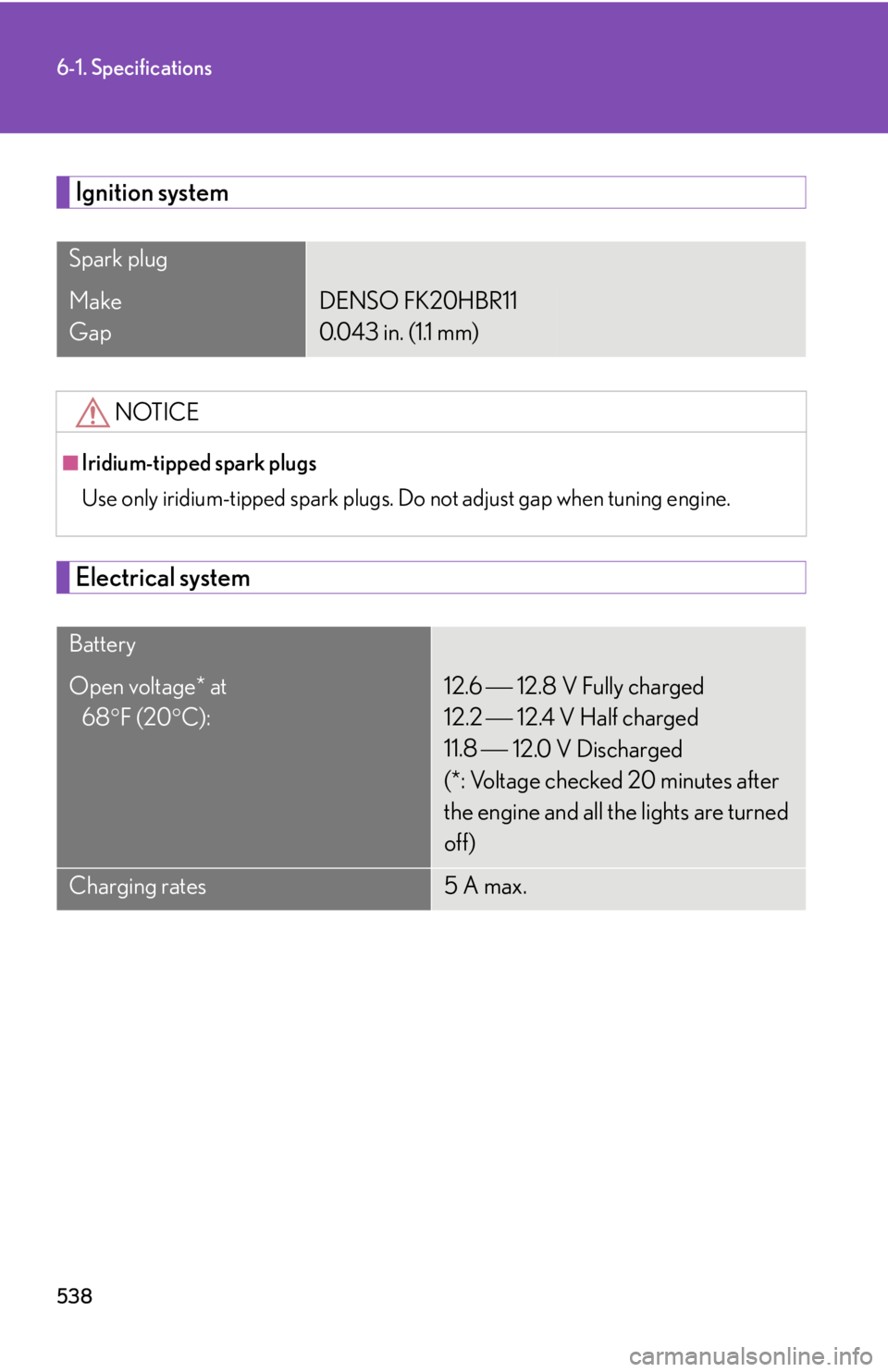
538
6-1. Specifications
Ignition system
Electrical system
Spark plug
Make
GapDENSO FK20HBR11
0.043 in. (1.1 mm)
NOTICE
■Iridium-tipped spark plugs
Use only iridium-tipped spark plugs. Do not adjust gap when tuning engine.
Battery
Open voltage* at
68 F (20 C):12.6 12.8 V Fully charged
12.2
12.4 V Half charged
11.8
12.0 V Discharged
(*: Voltage checked 20 minutes after
the engine and all the lights are turned
off)
Charging rates5 A max.
Page 541 of 592

541
6-1. Specifications
6
Vehicle specifications
Brakes
*1: Minimum pedal clearance when depressed with a force of 110 lbf (490 N, 50kgf) while the engine is running.
*2: Parking brake pedal travel when depressed with a force of 67.4 lbf (300 N,30.6 kgf).
*3: Parking brake lever travel when pulled up with a force of 45.0 lbf (200 N, 20.4kgf).
Pe d a l c l e a r a n c e *1
IS 350C
IS 250C
Manual transmission
Automatic transmission4.13 in. (105 mm) Min.
4.09 in. (104 mm) Min.
4.3 in. (108 mm) Min.
Pedal free play0.04 0.08 in. (1.0 2.0 mm)
Brake pad wear limit0.04 in. (1.0 mm)
Parking brake lining wear limit0.04 in. (1.0 mm)
Parking brake pedal travel *2/
lever travel
*3
Pe d a l t y p e
Lever type7 9 clicks
5
7 clicks
Fluid typeSAE J1703 or FMVSS No. 116 DOT 3
Page 548 of 592
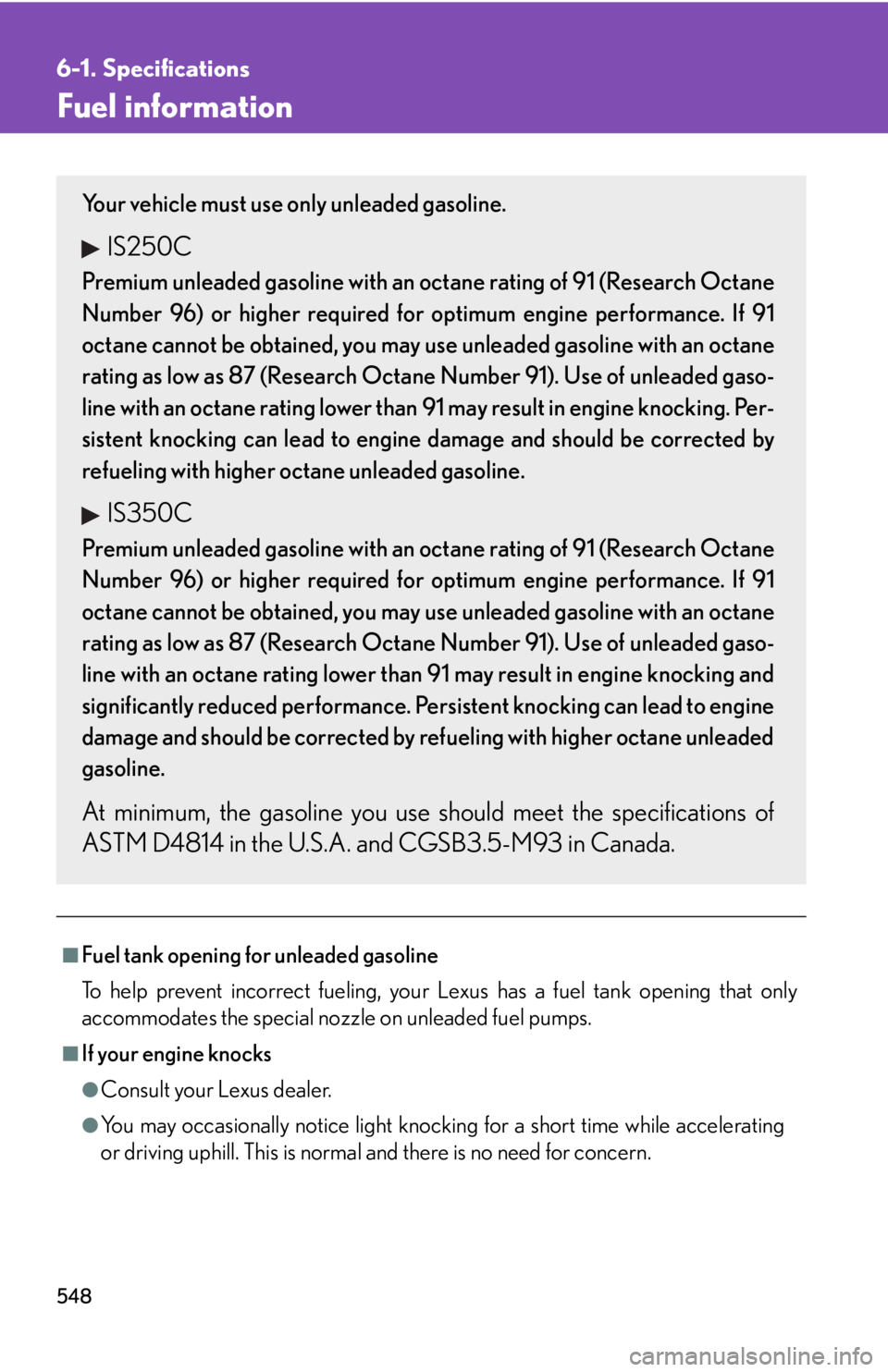
548
6-1. Specifications
Fuel information
■Fuel tank opening for unleaded gasoline
To help prevent incorrect fueling, your Lexus has a fuel tank opening that only
accommodates the special nozzle on unleaded fuel pumps.
■If your engine knocks
●Consult your Lexus dealer.
●You may occasionally notice light knocking for a short time while accelerating
or driving uphill. This is normal and there is no need for concern.
Your vehicle must use only unleaded gasoline.
IS250C
Premium unleaded gasoline with an oc tane rating of 91 (Research Octane
Number 96) or higher required for optimum engine performance. If 91
octane cannot be obtained, you may us e unleaded gasoline with an octane
rating as low as 87 (Research Octane Number 91). Use of unleaded gaso-
line with an octane rating lower than 91 may result in engine knocking. Per-
sistent knocking can lead to engine damage and should be corrected by
refueling with higher octane unleaded gasoline.
IS350C
Premium unleaded gasoline with an oc tane rating of 91 (Research Octane
Number 96) or higher required for optimum engine performance. If 91
octane cannot be obtained, you may us e unleaded gasoline with an octane
rating as low as 87 (Research Octane Number 91). Use of unleaded gaso-
line with an octane rating lower than 91 may result in engine knocking and
significantly reduced perf ormance. Persistent knocking can lead to engine
damage and should be corrected by refueling with higher octane unleaded
gasoline.
At minimum, the gasoline you us e should meet the specifications of
ASTM D4814 in the U.S.A. an d CGSB3.5-M93 in Canada.
Page 549 of 592
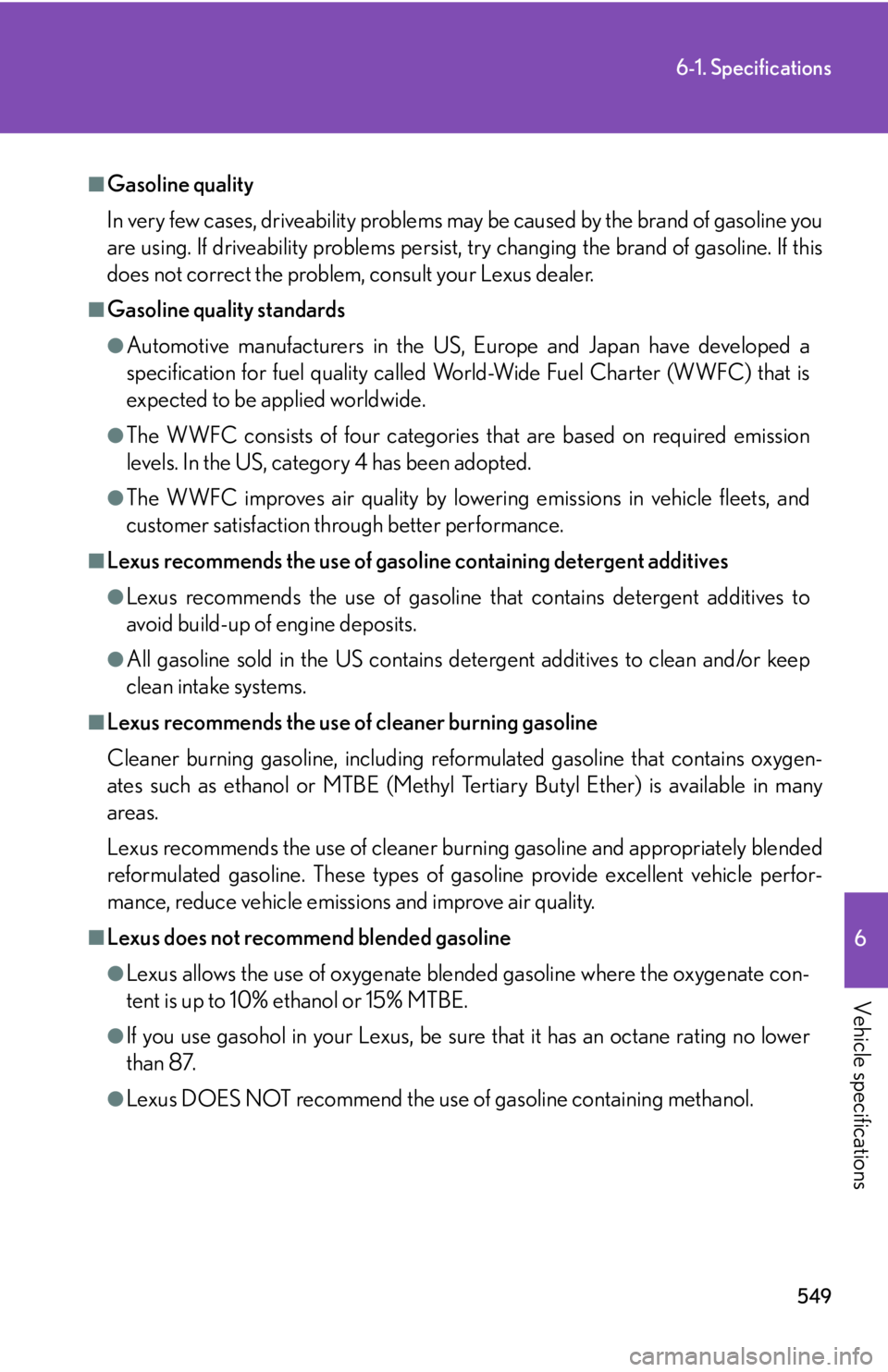
549
6-1. Specifications
6
Vehicle specifications
■Gasoline quality
In very few cases, driveability problems may be caused by the brand of gasoline you
are using. If driveability problems persist, try changing the brand of gasoline. If this
does not correct the problem, consult your Lexus dealer.
■Gasoline quality standards
●Automotive manufacturers in the US, Europe and Japan have developed a
specification for fuel quality called World-Wide Fuel Charter (WWFC) that is
expected to be applied worldwide.
●The WWFC consists of four categories that are based on required emission
levels. In the US, category 4 has been adopted.
●The WWFC improves air quality by lowering emissions in vehicle fleets, and
customer satisfaction th rough better performance.
■Lexus recommends the use of gasoline containing detergent additives
●Lexus recommends the use of gasoline that contains detergent additives to
avoid build-up of engine deposits.
●All gasoline sold in the US contains de tergent additives to clean and/or keep
clean intake systems.
■Lexus recommends the use of cleaner burning gasoline
Cleaner burning gasoline, including reform ulated gasoline that contains oxygen-
ates such as ethanol or MTBE (Methyl Te rtiary Butyl Ether) is available in many
areas.
Lexus recommends the use of cleaner burning gasoline and appropriately blended
reformulated gasoline. These types of gasoline provide excellent vehicle perfor-
mance, reduce vehicle emissions and improve air quality.
■Lexus does not recommend blended gasoline
●Lexus allows the use of oxygenate blended gasoline where the oxygenate con-
tent is up to 10% ethanol or 15% MTBE.
●If you use gasohol in your Lexus, be sure that it has an octane rating no lower
than 87.
●Lexus DOES NOT recommend the use of gasoline containing methanol.
Page 550 of 592
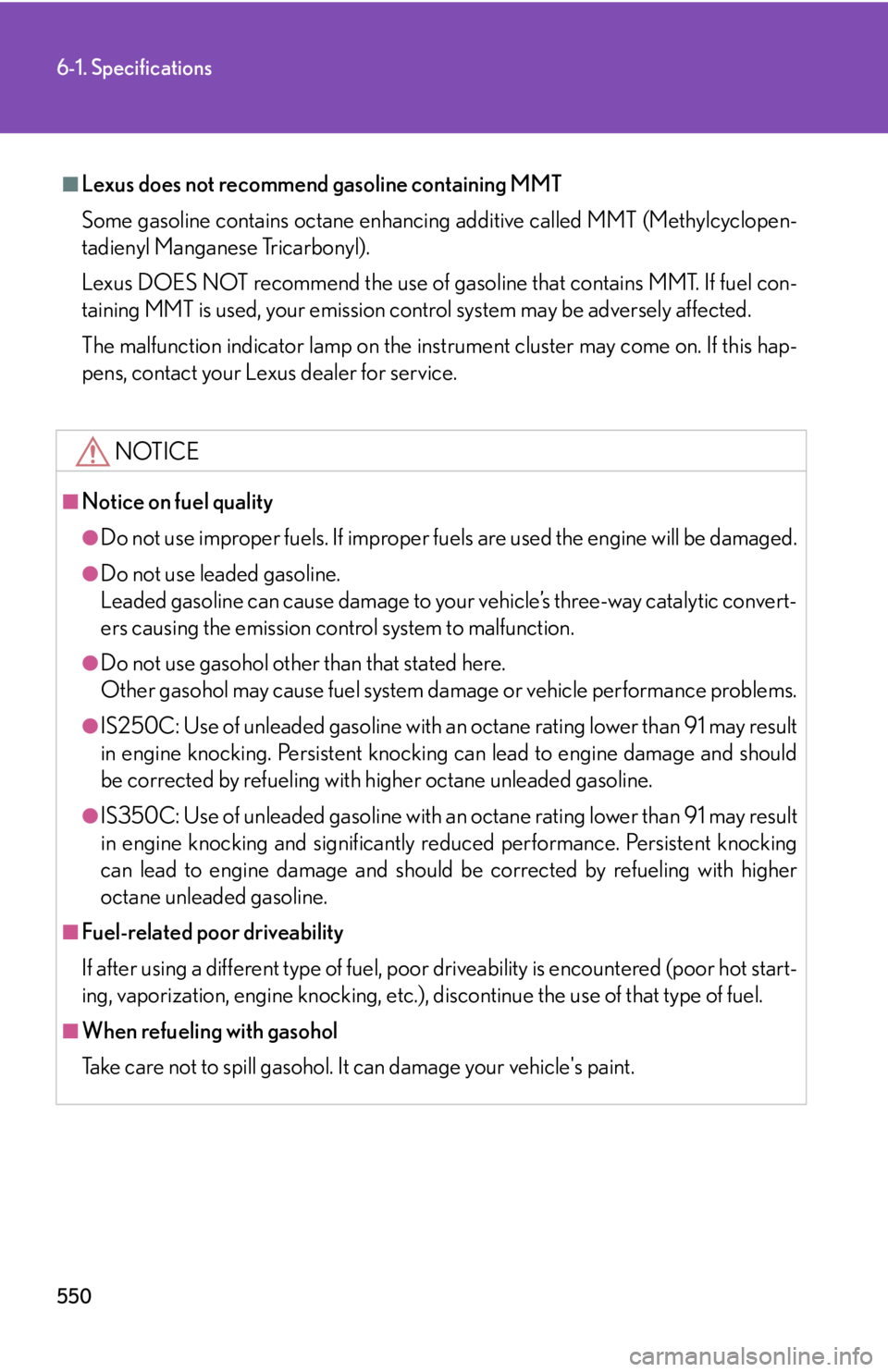
550
6-1. Specifications
■Lexus does not recommend gasoline containing MMT
Some gasoline contains oc tane enhancing additive called MMT (Methylcyclopen-
tadienyl Manganese Tricarbonyl).
Lexus DOES NOT recommend the use of gasoline that contains MMT. If fuel con-
taining MMT is used, your emission control system may be adversely affected.
The malfunction indicator lamp on the inst rument cluster may come on. If this hap-
pens, contact your Lexus dealer for service.
NOTICE
■Notice on fuel quality
●Do not use improper fuels. If improper fuels are used the engine will be damaged.
●Do not use leaded gasoline.
Leaded gasoline can cause damage to your vehicle’s three-way catalytic convert-
ers causing the emission control system to malfunction.
●Do not use gasohol other than that stated here.
Other gasohol may cause fuel system damage or vehicle performance problems.
●IS250C: Use of unleaded gasoline with an octane rating lower than 91 may result
in engine knocking. Persistent knocking can lead to engine damage and should
be corrected by refueling with higher octane unleaded gasoline.
●IS350C: Use of unleaded gasoline with an octane rating lower than 91 may result
in engine knocking and significantly re duced performance. Persistent knocking
can lead to engine damage and should be corrected by refueling with higher
octane unleaded gasoline.
■Fuel-related poor driveability
If after using a different type of fuel, poor driveability is encountered (poor hot start-
ing, vaporization, engine knoc king, etc.), discontinue the use of that type of fuel.
■When refueling with gasohol
Take care not to spill gasohol. It can damage your vehicle's paint.
Page 557 of 592
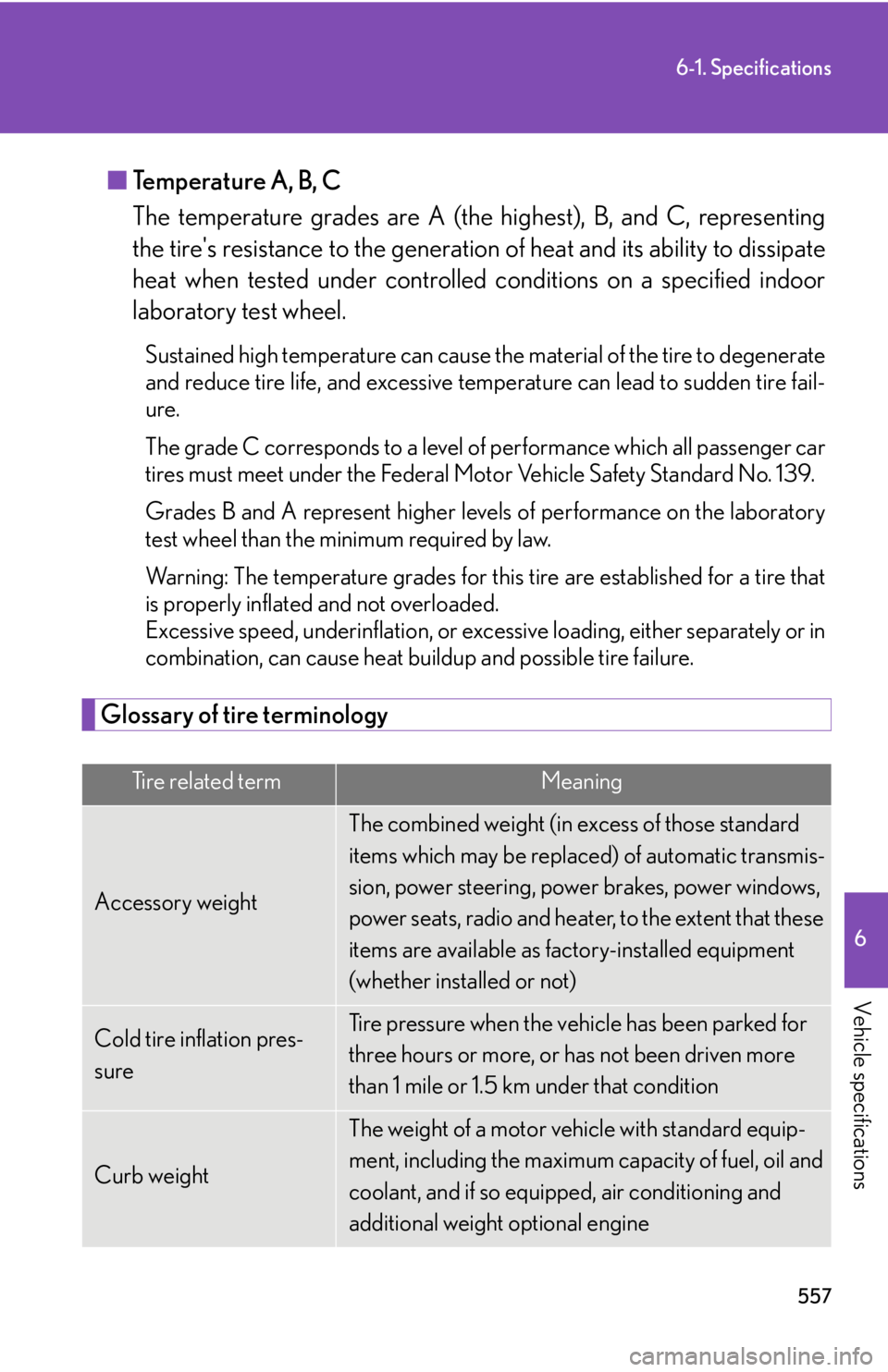
557
6-1. Specifications
6
Vehicle specifications
■Temperature A, B, C
The temperature grades are A (the hi ghest), B, and C, representing
the tire's resistance to the generation of heat and its ability to dissipate
heat when tested under controlled conditions on a specified indoor
laboratory test wheel.
Sustained high temperature can cause the material of the tire to degenerate
and reduce tire life, and excessive temperature can lead to sudden tire fail-
ure.
The grade C corresponds to a level of performance which all passenger car
tires must meet under the Federal Mo tor Vehicle Safety Standard No. 139.
Grades B and A represent higher levels of performance on the laboratory
test wheel than the minimum required by law.
Warning: The temperature grades for this tire are established for a tire that
is properly inflated and not overloaded.
Excessive speed, underinflation, or excess ive loading, either separately or in
combination, can cause heat build up and possible tire failure.
Glossary of tire terminology
Tire related termMeaning
Accessory weight
The combined weight (in excess of those standard
items which may be replaced) of automatic transmis-
sion, power steering, power brakes, power windows,
power seats, radio and heater, to the extent that these
items are available as factory-installed equipment
(whether installed or not)
Cold tire inflation pres-
sureTire pressure when the vehicle has been parked for
three hours or more, or has not been driven more
than 1 mile or 1.5 km under that condition
Curb weight
The weight of a motor vehicle with standard equip-
ment, including the maximum capacity of fuel, oil and
coolant, and if so equipped, air conditioning and
additional weight optional engine
Page 568 of 592

568
6-2. Customization
Multi-information display (P. 169)
Illumination
(
P. 3 3 8 )
Time elapsed before lights
turn off15 seconds7. 5 s e c o n d s
30 seconds
Operation when the
doors are unlockedOnOff
Operation after the
“ENGINE START STOP”
switch is turned OFF
OnOff
Front foot well lightsOnOff
Shift lever lightOnOff
Outer foot lightOnOff
Available languageEnglish and French
ItemFunctionDefault settingCustomized
setting
Page 569 of 592

569
6
Vehicle specifications
6-3. Initialization
Items to initialize
ItemWhen to initializeReference
Engine oil maintenance
data (U.S.A. only)After changing engine oilP. 4 0 1
Tire pressure warning
system
• When changing the tire inflation pressure by changing traveling
speed.
• When changing the tire size.
P. 4 1 2
The following item must be initialized for normal system operation in cases
such as after the battery is reconnected, or maintenance is performed on
the vehicle.